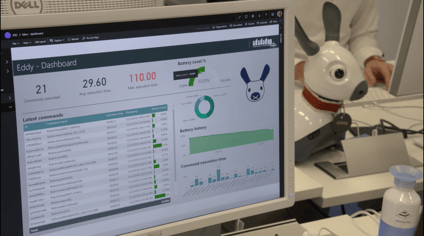Putting digital transformation into practice
Companies often struggle with what it means to become digital. To us, it means using data – to drive automated decision making and thus make business processes or systems smarter. The goal of digital transformation is to dramatically change your product or service giving it a new stunning and smart experience. Data proves to be essential in this.
What digital transformation looks like: Eddy the office dog
 The term digital transformation might become more vivid when we explain it with an example. At Itility, we have our own office dog, a robot named “@i” (pronounced as Eddy). Making Eddy act autonomously entails aspects of digital transformation and highlights the different elements that are needed in this journey. We think Eddy will fill in a social role within our office, giving us and our customers on the floor just that tiny bit of a digital experience.
The term digital transformation might become more vivid when we explain it with an example. At Itility, we have our own office dog, a robot named “@i” (pronounced as Eddy). Making Eddy act autonomously entails aspects of digital transformation and highlights the different elements that are needed in this journey. We think Eddy will fill in a social role within our office, giving us and our customers on the floor just that tiny bit of a digital experience.
Becoming digital often starts with teaching a system to execute tasks that humans normally do, by using software and data. The system – in this case the dog – needs to be self-learning to become smarter. In contrast to humans – who are hardwired from the start to self-learn – many steps must be taken to make Eddy self-learning.
Transforming data about what Eddy sees, hears, and senses into actions
The first step is to collect as much data as possible. For this, Eddy has all kinds of sensors that act as his eyes, ears, and other senses. We need a central place to store and digest the data that Eddy’s sensors collect. Using wifi, we send raw sensor data to a storage unit in the cloud: our data factory. Similar to a physical factory, this raw material needs to be processed into a useful product. For instance, Eddy collects sound-data with his ears. But these sound bites cannot be used on their own. They are converted to meaningful text, which in turn can be used by our data scientists to perform natural language processing. Words are then filtered from the text and paired with a specific instruction that is sent back to Eddy. So, when Eddy hears ‘come here, boy’ the word ‘come’ is extracted from the sound file and linked to a piece of code telling Eddy what to do when he hears it. This transformation of sound into text into commands takes place in our data factory, and the factory output in this case is the code that is sent back to Eddy ordering him to move his ‘feet’ and stroll towards where the sound came from.
 So, the data factory is the place where all raw sensor data is collected, processed and turned into code to describe specific actions. Multiple disciplines are needed for this. Firstly, there is a data engineer who creates code to continuously have sensor data from the dog enter into our factory. The data engineer also translates this raw data into useable information (such as the text files) and adds additional data about external factors (such as a time stamp or whether it is day or night). Finally, the data engineer makes sure that the data is safely stored, and that no one can access it without permission.
So, the data factory is the place where all raw sensor data is collected, processed and turned into code to describe specific actions. Multiple disciplines are needed for this. Firstly, there is a data engineer who creates code to continuously have sensor data from the dog enter into our factory. The data engineer also translates this raw data into useable information (such as the text files) and adds additional data about external factors (such as a time stamp or whether it is day or night). Finally, the data engineer makes sure that the data is safely stored, and that no one can access it without permission.
Alongside of this, a data analyst visualizes the data into useful dashboards that show the general behavior of the dog and of the collected data. For instance, it shows how often a command has been given to the dog, or how much battery power is used. It also predicts when the batteries need to be charged.
Next, data scientists within the factory make sure that Eddy learns the appropriate responses to given commands. They use algorithms and machine learning models to make the dog self-learning.
Itility and Eddy going to dog training
But making Eddy act smart requires more than just a one-off coding exercise. We have to run the factory as a non-stop production facility to have the dog operable every day and to have him learn continuously. After the first tricks, we need to set the next steps. This will mean handling more complex interactions and scenario’s step-by-step.
Therefore, we need to embed Eddy within our office processes. From that point on we can further develop his skills. So, if we want Eddy to direct guests to their meeting rooms, he needs to know how to work together with our receptionist and the guests. It needs to be incorporated in the receptionist’s way-of-working to rely on Eddy for this purpose, just as it needs to be incorporated in Eddy’s code that the receptionist receives a text message every time he has successfully dropped off a guest at the correct meeting room.
Digital transformation is all about data and learning from it
Eddy is a nice example of how digital transformation can be practiced. It’s about people, your business and what you want to achieve. Data showed critical for this. It is all about data and being able to use the insights retrieved from that data to develop your digital solutions and influence the experience.



